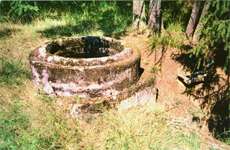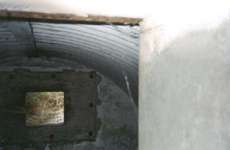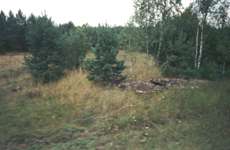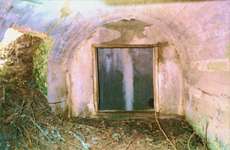 Fortifications near Szczytno were a part of German defence project beginning in 1898. This was the southwest wing prolongation of MLP (Mazurian Lakes Position). It was known as Position Nidzkie-Siodmak (Nieder-Schoben Stellung). Forest Position Szczytno (Ortelsburger Waldstellung) was situated near Nidzkie Lake, along the railway through Karwica, in north of Spychowo, and to the northwest avoiding the areas of Swietajno, Piasutno, Jerutki, Walpusz River, Szczytno, and Siodmak to Sasek Lake and the Sedanskie Lake. [Map]. In 1902 near Szczytno the German Army built three "forts Of infantry" (Infanteriewerke) and one HMG-tower (similar to those in Ruciane). Along these positions, Germany built 36 brick blockhouses (one for every 1/2 platoon of infantry). FPS was characterized by continuous anti-infantry hinderances. The
hinderances were usually 3-4 strands of coiled barbed wire with thin steel-wire (anti-cavalry lines) every 40-50m. In the mobilization period of June-July 1914, fortifications were supplemented by 44 wooden blokhouses being constructed. For the battles the German Army prepared some railway buildings, which doubled as fire positions. In the event of war, all of the sets of consolidations would had two battalions of infantry. In August of 1914, the fortifications became part of the XX Corps of the 8th German Army. This Corp retreated westward on the news of the defeats of the main force near Stolupiany and Gabin (August 19-20, 1914). The Russian 2nd Army ("Narew") crossed the border of Eastern Prussia in sector Wielbark - Nidzica on August 22, avoiding the Forest Position Szczytno from the west.
Fortifications near Szczytno were a part of German defence project beginning in 1898. This was the southwest wing prolongation of MLP (Mazurian Lakes Position). It was known as Position Nidzkie-Siodmak (Nieder-Schoben Stellung). Forest Position Szczytno (Ortelsburger Waldstellung) was situated near Nidzkie Lake, along the railway through Karwica, in north of Spychowo, and to the northwest avoiding the areas of Swietajno, Piasutno, Jerutki, Walpusz River, Szczytno, and Siodmak to Sasek Lake and the Sedanskie Lake. [Map]. In 1902 near Szczytno the German Army built three "forts Of infantry" (Infanteriewerke) and one HMG-tower (similar to those in Ruciane). Along these positions, Germany built 36 brick blockhouses (one for every 1/2 platoon of infantry). FPS was characterized by continuous anti-infantry hinderances. The
hinderances were usually 3-4 strands of coiled barbed wire with thin steel-wire (anti-cavalry lines) every 40-50m. In the mobilization period of June-July 1914, fortifications were supplemented by 44 wooden blokhouses being constructed. For the battles the German Army prepared some railway buildings, which doubled as fire positions. In the event of war, all of the sets of consolidations would had two battalions of infantry. In August of 1914, the fortifications became part of the XX Corps of the 8th German Army. This Corp retreated westward on the news of the defeats of the main force near Stolupiany and Gabin (August 19-20, 1914). The Russian 2nd Army ("Narew") crossed the border of Eastern Prussia in sector Wielbark - Nidzica on August 22, avoiding the Forest Position Szczytno from the west.
At this time a new commander of the 8th German Army was appointed. He was General Paul von Hindenburg (along with General Erich Ludendorf) and using superior tactics dispersed the Russian 2nd Army (the 1st Russian Army stayed near Wystruc-Wegorzewo). In the battle near Tannenberg (Stebark) and Hohenstein (Olsztynek) on 26-31st of August, the Germans circled and almost completely ravaged the Russian 2nd Army. About 150000 Russians soldiers were either casualties or prisoners of war! Hinderances and forest - fortifications additionally made it relatively easy for the Germans to catch Russian stragglers. In the forests near Szczytno, the unhappy commander of the broken 2nd Army "Narew", General Andriej Samsonow, shot himself. A second Russian offensive, in the autumn of 1914, was attempted without success near Ruciane-Nida.
In 1925, in the areas near Szczytno, the Allied Inspection Committee group recognized there were
 several new illegal (prohibited by Treaty of Versailles) shelters for infantry. As a result of the Paris - Conference (1926), Germany was allowed to replace deteriorating buildings with new units. In place of the wooden and brick blockhouses, the Germans built, in the summer of 1928, 17 passive shelters for one squad of infantry "Gruppenunterstand" and 15 for two squads, the "Doppelgruppenunterstand". These structures had walls of reinforced concrete, 1m thick and ceilings of 0,8m thickness (class B1). Included were gas filters and reserve exits. Further modernization of these positions was made in 1939, including the FPS for planned mobilizations and fortifications along the borders Of East Prussia (with Positions: Pisz, Olsztynek, and field - fortifications Ilawa, Gardeja, Dzierzgon, Lega River and Orzysz). Near the main roads the Germans constructed 7 raised combat bunkers for HMG "MG-Schartenstand D" (formed from wavy sheet metal "Heinrich" and concrete). These bunkers possessed fighting room behind armour plate, type 422P01, and 0,6m thick conrcete walls. HMG type 08 or 34, placed on steel - pegs, were installed on walls under embrasures. The schelters' schemes and armament. In the period of mobilization of 1939, the Germans developed field positions for HMGs, trenches were strengthened with fascine. In September 1939 the FPS fulfilled part of the protection plan of concentrating the German Corps "WODRIG" (1st Infantry Division, 12th Infantry Division, 1st Brigade of Cavalry).
several new illegal (prohibited by Treaty of Versailles) shelters for infantry. As a result of the Paris - Conference (1926), Germany was allowed to replace deteriorating buildings with new units. In place of the wooden and brick blockhouses, the Germans built, in the summer of 1928, 17 passive shelters for one squad of infantry "Gruppenunterstand" and 15 for two squads, the "Doppelgruppenunterstand". These structures had walls of reinforced concrete, 1m thick and ceilings of 0,8m thickness (class B1). Included were gas filters and reserve exits. Further modernization of these positions was made in 1939, including the FPS for planned mobilizations and fortifications along the borders Of East Prussia (with Positions: Pisz, Olsztynek, and field - fortifications Ilawa, Gardeja, Dzierzgon, Lega River and Orzysz). Near the main roads the Germans constructed 7 raised combat bunkers for HMG "MG-Schartenstand D" (formed from wavy sheet metal "Heinrich" and concrete). These bunkers possessed fighting room behind armour plate, type 422P01, and 0,6m thick conrcete walls. HMG type 08 or 34, placed on steel - pegs, were installed on walls under embrasures. The schelters' schemes and armament. In the period of mobilization of 1939, the Germans developed field positions for HMGs, trenches were strengthened with fascine. In September 1939 the FPS fulfilled part of the protection plan of concentrating the German Corps "WODRIG" (1st Infantry Division, 12th Infantry Division, 1st Brigade of Cavalry).
In 1944 German Army Command planned to form three zones of defence around East Prussia. The first zone was a tactical, five km front-zone along Narev River. The second belt of defence known as the Border Position was placed near the line Wielbark - Myszyniec - Turosl. The third and final line, was the main Forest Position Szczytno.
The Germans renewed their positions with many "Kochbunkers" Wehrmacht soldiers sarcastically referred to these fortifications as "Kochtöpfe" (Koch's pot). Kochbunkers consisted from concrete 1,2m and sides of 10cm thickness, with gun ring - carriages for HMG type 34/42. These structures enlarged the possibility of circuitous defence-fire. Some Kochbunkers possessed observation or combat cupolas made of concrete. Using similar designs, they prepared shelters for anti-tank defences employing
 Panzerfaust weapons, for shelters for infantry or for simple ammunition wells. Kochbunkers were a flexible solution and given that they could be produced 'en masse' and were transportable from place to place, they were widely developed and added to existing shelters. In threatened places they built three lines with Kochbunkers, trenches and old shelters. They also built several new shelters for infantry and command posts from series 600 designs (projected for Atlanticwall) with 2m reinforced concrete walls and ceilings. This was type-Regelbau 621 and 668.
The Germans prepared defences for Szczytno with continuous anti-tank ditches. These supplemented and renewed old barbed wire barriers. Sappers mined the foregrounds of these positions as well as all forest roads. Deep inside the defence-line they prepared wood barriers.
Panzerfaust weapons, for shelters for infantry or for simple ammunition wells. Kochbunkers were a flexible solution and given that they could be produced 'en masse' and were transportable from place to place, they were widely developed and added to existing shelters. In threatened places they built three lines with Kochbunkers, trenches and old shelters. They also built several new shelters for infantry and command posts from series 600 designs (projected for Atlanticwall) with 2m reinforced concrete walls and ceilings. This was type-Regelbau 621 and 668.
The Germans prepared defences for Szczytno with continuous anti-tank ditches. These supplemented and renewed old barbed wire barriers. Sappers mined the foregrounds of these positions as well as all forest roads. Deep inside the defence-line they prepared wood barriers.
Staff of Group Army "Mitte" ("Centre") stationed in Szczytno. They controlled the area from Memel (Klajpeda) to Modlin (near Warsaw) with three armies (2nd Army, 4th Army and 3rd Tank Army). Near Wielbark and Chorzele were grouped the strong reserve Corp "Grossdeutschland" and 83rd Infantry Division. After the breakthrough by the 2nd Belorussian Front, of the German tactical zone of defence on 22 I 1945, Hitler allowed them to retreat and re-set in the Forest Position Szczytno. Commander GoA "Mitte", General Reinhardt delivered Hitler's orders to General Hossbach (commander 4th Army). Hossbach understood it as a signal for a general retreat, which had to be protected by Forest Position Szczytno and from the north by Position of Mazurian Channel. The Commander of the 4th Army apparently did not even consider the potential of the defence of the prepared fortifications in Great Mazurian Lakes region and so ignored them. He apparently could not reconcile the thought playing the part of a second Paulus (Stalingrad). OKH (German Army Headquarters) and Hitler attentively observed the activities of the 4th Army. In an atmosphere heated up by telephone calls from a terrified Gauleiter Koch, who correctly read Hossbach's and Reinchardt's intentions, arose a situation causing much confusion. By 23 I 1945, Hitler ordered a return and re-setting not of Forest - Position, but of the Border Position. There was only one problem. This position existed only on his ordnance map (the 4th Army hadn't had time to construct this line). In consequence of the chaos, the 3rd Russian Army took Szczytno and all of the railway in the direction of Olsztyn. In the region of fortifications, the Russians (49th Army) pushed a broken XXth German Corps.
The German's situation was serious, with the only means of evacuation of the civilian population and of the armies from south-east area of Prussia being by railway and road: Pisz -
 Ruciane - Mragowo - Lidzbark Warminski. On 25 I 1945, Russians appeared in the belt Wielbark - Rozogi - Karwica. At this time the pressure of 2nd Belorussian Front was clearly weakened. The Forces of Marshal Rokossowski were sent to rescue the situation in the region of Paslek - Elblag. Battles in the region northwest of Kiejkuty-Spychowo-Ruciane 25/26 I 1945 took on the character of a forest battle. German forces withdrew to the region of the Lidzbark Triangle.
During the night of 26/27 I 1945, retreating squads ravaged bridges and viaducts. The commander of the 2nd BF, Marshal Rokossowski admitted that the introduction of the 49th Army to the "breaking forest - position in difficult ground" could have been avoided, if the neighbouring 50th Army had not delayed for two days in front of the empty German trenches near the Narev River. Later, the commander of this Army, General Boldin executed a great "flanking manoeuvre" in the region of the Pisz and the Elk. There a compressing ring of encirclement was established around non-existent German armies, instead of attacks on the Forest Position Szczytno.
Ruciane - Mragowo - Lidzbark Warminski. On 25 I 1945, Russians appeared in the belt Wielbark - Rozogi - Karwica. At this time the pressure of 2nd Belorussian Front was clearly weakened. The Forces of Marshal Rokossowski were sent to rescue the situation in the region of Paslek - Elblag. Battles in the region northwest of Kiejkuty-Spychowo-Ruciane 25/26 I 1945 took on the character of a forest battle. German forces withdrew to the region of the Lidzbark Triangle.
During the night of 26/27 I 1945, retreating squads ravaged bridges and viaducts. The commander of the 2nd BF, Marshal Rokossowski admitted that the introduction of the 49th Army to the "breaking forest - position in difficult ground" could have been avoided, if the neighbouring 50th Army had not delayed for two days in front of the empty German trenches near the Narev River. Later, the commander of this Army, General Boldin executed a great "flanking manoeuvre" in the region of the Pisz and the Elk. There a compressing ring of encirclement was established around non-existent German armies, instead of attacks on the Forest Position Szczytno.
From February to August 1945, special Russian groups disassembleed all installations, machines etc. By way of example, these groups disassembled and took all of the railroad mechanisms from the Szczytno-Mragowo-Pisz-Orzysz-Elk region. Simultaneously, Russian sappers destroyed all old blockhouses along railway line. Polish sappers later in 1950/55 identified and destroyed continuous mine fields, detonating the munitions. In 1945/50 these forests continued to support many armed groups, including the AK - WiN (Polish anticommunist), Wehrwolf (German resistance) and Kurpie looters and thieves (these were the most dangerous from all!). In 1950 the Polish Command cataloged the remaining objects on the FPS (& other positions) for planned mobilizations of the regions. After Poland agreed to the Warsaw Pact, military artifacts wasted away completely, lost military meaning and went into oblivion.

